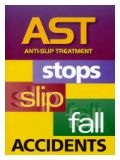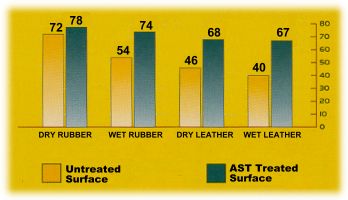

 |
AST - Anti Slip Treatment
 Today, with slip and fall accidents resulting in
expensive lawsuits, costly compensation claims and escalating insurance premiums, owners
and managers of buildings and businesses have a problem that can no longer be ignored.
Today, with slip and fall accidents resulting in
expensive lawsuits, costly compensation claims and escalating insurance premiums, owners
and managers of buildings and businesses have a problem that can no longer be ignored.
Fortunately, AST’s patented two-part process was developed to combat this growing concern that is costing millions every year. The AST system was developed specifically to combat the slippery conditions on wet tile floors. This superior system is just what was needed.
What is AST?
AST is the newest technology available to make existing hard floor surfaces slip resistant
in wet conditions. It can be applied, indoors or outdoors, on ceramic, quarry, porcelain,
glazed tiles, terrazzo, granite, marble and concrete. AST is invisible, will not discolor,
peel, chip or crack and cannot be removed once applied.
How Does AST Work?
This anti-slip effect is achieved from the formation of tiny, cup-shaped structures
created on the floor surface when the AST Activator is applied. When walked on these
valleys act like thousands of tiny suction cups displacing water and creating a vacuum
effect, from the pressure of the foot. AST makes the level of slip resistance even greater
when the Fixative is blended with the Activator. This mixture creates abrasive crystals,
which increases traction on the surface. The slip resistance achieved with the crystalline
structure makes AST unique to any other chemical alteration. The crystalline structures
also increase the abrasion resistance of the tile, which make the tile harder and increase
its life expectancy.
AST:
![]() Reduces costly concerns related to slip fall
accidents
Reduces costly concerns related to slip fall
accidents
![]() Two part chemical process that dramatically increases
traction
Two part chemical process that dramatically increases
traction
![]() Eliminates costs related to lawsuits
Eliminates costs related to lawsuits
![]() Reduces compensation claims
Reduces compensation claims
![]() Reduces ever increasing insurance premiums
Reduces ever increasing insurance premiums
![]() Improves traction in wet and dry conditions
Improves traction in wet and dry conditions
![]() AST is NOT Acid Etching
AST is NOT Acid Etching
![]() Makes tile floors safe without altering their appearance
Makes tile floors safe without altering their appearance
![]() Increased the life span of the tile surface
Increased the life span of the tile surface
![]() Is easy to maintain, unlike other slip resistant
alterations
Is easy to maintain, unlike other slip resistant
alterations
![]() Lasts up to 5 years
Lasts up to 5 years
![]() AST is the newest technology available to make existing
floors slip resistant in wet conditions
AST is the newest technology available to make existing
floors slip resistant in wet conditions
 |
 |
| These photographs were taken with an electron microscope enhanced 35,000 times to show you the unique crystallization process that takes place after the application of our AST product. | |
AST
Tile Abrasion Test
This test measurement is done with an abrasive pad on a rotating disc. The measurement is
based on the number of rotations completed before any signs of wear on the surface exist.
Notice that the treated tile has an increased hardness level of over 22%
| Surface of Un-Treated Glazed. 254 Rotations | Glazed Tile Treated with AST. 309 Rotations |
| Abrasion
Tests (Copies available upon request) |
|
Co-efficient
of Friction Test
Co-efficient of friction (COF) is the measurement for the traction (friction) level on a
surface. National Floor Safety Group has had various tests done by professional testing
companies to measure the level of slip resistance attained after a tile surface has been
treated. Consistently the results have proven to be astonishing, with outstanding
increases in the friction levels not only on wet, but also dry surfaces.
Increased
Traction on Tile Treated with AST Co-efficient of Friction Tests (Copies available upon request) |
Where Does AST Work?
AST can be applied to any Hard Mineral Surface.
 How
Long Will A Treatment Last?
How
Long Will A Treatment Last?
The life of the treatment depends on the foot traffic of the surface treated.
On average, AST will last up to 5 years. As it is not just a coating,
AST becomes an integral part of a tile’s glaze, and cannot be washed
away or affected by sunlight or cleaning chemicals. The anti-slip effect
an AST treatment has on a floor surface is a semi-permanent alteration.
How Much Does It Cost?
Depending on volume, AST can be applied for about $1.50 per square foot.
However, prices can vary depending on the surface being treated, the hardness
and strength of the existing floor material.
Who Applies AST?
With every AST purchase an installation training video is supplied. This
video will demonstrate the ease of AST installation which will give almost
anyone the ability to install AST. If you prefer an existing dealer
can install AST for you.
How
Long Does An AST Application Take?
There is virtually no down time required for an AST application. 300 square
feet can be treated in one hour, which allows most floors to be treated
in off hours.
What
Preparation is Needed for an AST Application?
Prior to any application, the floor needs to be thoroughly degreased and
dry. Once this has been achieved AST installation can begin.
Normally we ask that you:
![]() Follow your daily maintenance routine
Follow your daily maintenance routine
![]() Remove any debris from the site
Remove any debris from the site
![]() Remove any sealer or wax previously applied to the
surface
Remove any sealer or wax previously applied to the
surface
![]() Move any furniture, matting, or valuable items that may
be damaged from over spray.
Move any furniture, matting, or valuable items that may
be damaged from over spray.
 What Maintenance is
Required For AST Treated Floors?
What Maintenance is
Required For AST Treated Floors?
After an AST Treatment your wet floor will be slip resistant, but if not properly
maintained you may slip on grease and dirt build-up. Standard cleaning procedures
will generally apply to a floor that has been treated with AST. In heavily soiled areas we
recommend that the floor be scrubbed with a broom rather then mopped, as the floor will
usually be cleaned better this way.
Recommended Maintenance Process
- Dilute a HEAVY DUTY CLEANER using the manufactures recommended dilutions on the degree of soiling.
- Apply the solution to the floor and scrub with a mop and/or a broom.
- Pick up the resulting solution with a mop or squeegee the liquid into a floor drain, if floor drains are unavailable, remove the liquid from the floor with a wet/dry vacuum, or squeegee it into a corner and pick it up with a clean mop.
- Rinse the floor with fresh water.

The National Floor Safety Group Ltd. exclusively offers AST in North America, with independent dealers trained to apply AST on existing floor surfaces.
Over 30 years of making floors safer.
To be connected with a local dealer please contact us.
| AST (Anti Slip Treatment) | |
| NEV-R-SLIP | |
| SAFETY GROOVING | |
| FLOOR SAFETY PRODUCTS | |
| LOOKUP LOCAL DEALER | |
developer@versys.net |

|